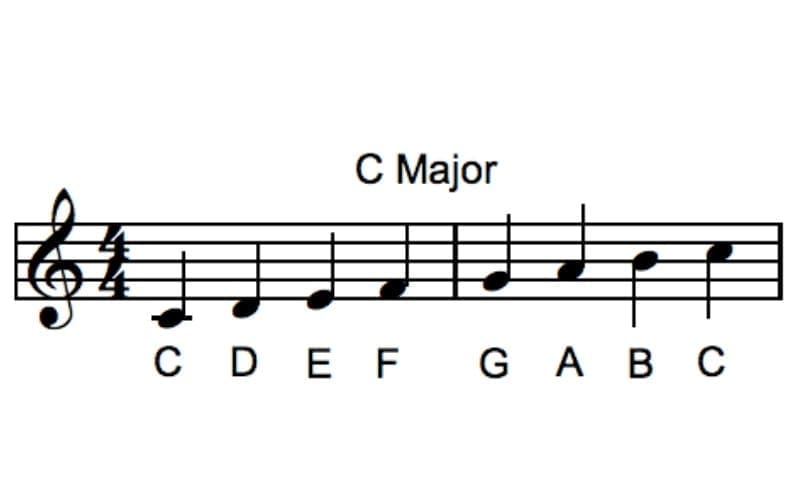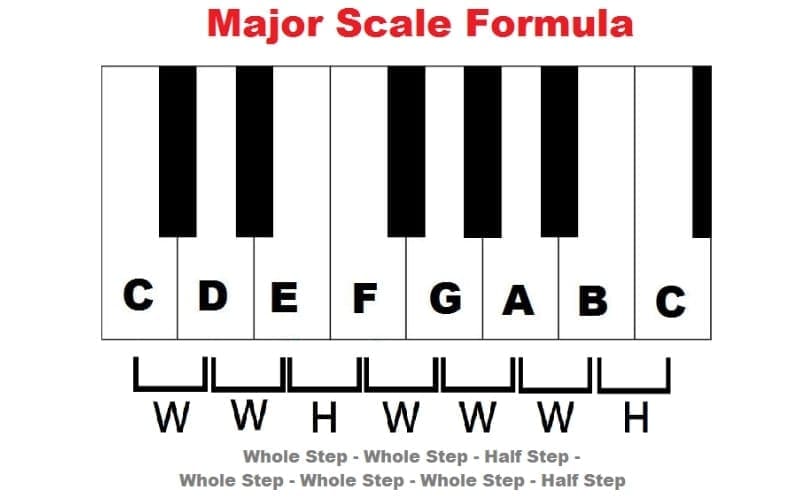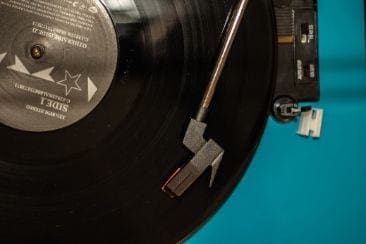In music theory, scales are one of the most important things you’ll learn. It’s the foundation of music, and learning scales and scale charts will vastly improve your songwriting and ability to learn new music. That’s why I will be providing you with a music scale definition, plus the tools to work them out on your own.
Most of us already subconsciously know music scales and can sing them as we’ve been exposed to music from a young age. If someone sang a couple of notes and asked you to sing the next one, you’d be able to do it – but perhaps not know how.
In this article, we’ll look at different diatonic scales in music, tones and semitones, chromatic scale, interval patterns, tone scale, what is a leading tone and how major key, and scale degree work within western music and how to use scales to make music and improve your songwriting!
What Are Musical Scales?
Musical scales are groups of notes (12 notes per scale) which sound pleasant when played in or out of sequence, ascending or descending. If you’ve ever heard somebody doing a vocal warm-up, they are usually singing scales. This definition can be seen as a crude way of explaining this topic, however, it will set you on the right path for exploration.
A more simple scale definition for music is that each musical scale’s notes can be seen as the alphabet of a language. Just like different languages have different alphabets or letters, each musical scale includes different notes or letters.
There are many different types of scales in music. For example, major and minor scales in music are the most common. We’ll start with the most basic musical scale, which is known as the Major scale.
Major Scales
The first step to working out a major scale is to write down the first 7 letters from the alphabet, starting from A (A B C D E F G). Let’s have a look at our first major scale, starting on the C note. In order to do this, all you have to do is rewrite the same order of notes but start from C (C D E F G A B).

If you’ve ever played the piano, you may notice that these are the same notes as the white keys. So, if you played all the white keys from C to B, you’d hear a Major scale. This is a great way of playing your first of many music scales on the piano!
So, that was our first Major scale. As we are starting from note C, this will be referred to as the C Major scale. The note at the start of a musical scale usually determines the musical scales’ names. In this case, it was a major scale starting with C. Thus, it’s called the C Major scale.
Now, you must be thinking ‘what if I start the same scale from a different letter, like G? Would that make it a G Major scale?’ Great thinking – however, it’s not quite as simple as that. You are on the right track, though!
How To Work Out Any Major Scale
Now that we have established that the C Major scale has 7 notes starting from C and ending at B, let’s move ahead and understand how to work out any Major scale.
Major scales follow this pattern in regard to the leaps between the notes:
Whole, Whole, Half, Whole, Whole, Whole, Half

A whole step is called a tone. On a piano, it means moving up 2 keys or ‘half steps’ (including black notes). So, an example of a whole step is from C – D, because I move up one to C#, and then again to D.
A half step is called a semitone. On a piano, it means moving up 1 key (including black notes). An example of a half step is from C – C# because I simply move up one key, from white to black.
If you look at the C major scale and count up on the image of the piano using the pattern below, you’ll see that it follows this pattern of steps:
C (W) D (W) E (H) F (W) G (W) A (W) B (H) C
Don’t forget also, that some keys include Flats (b) and Sharps (#). These are the black notes on a piano, if it’s to the left of the note, it is flat. If it is to the right of the note, it is sharp. So, if you were working out the scale of Bb Major, the same pattern still applies.
Bb (W) C (W) D (H) Eb (W) F (W) G (W) A (H) Bb
An Alternative Method: Working Out Major Scales
If this isn’t sitting right in your brain – no need to panic. Alternatively, there is a method known as the “number” system. Here are the simple steps:
- Give a number to each note in the scale – let’s start with C Major (e.g. C = 1, D = 2 and so on).
- Restart the scale starting from the 5th note – which in this case is G. This is how it will look: G A B C D E F. This is how we’re going to work out the G Major scale.
- Assign numbers to this scale too (G = 1, A = 2 and so on)
- Make the seventh note (in this case F) a sharp (#). This means the G Major scale will be G A B C D E F#.
You can keep doing these steps to work out any Major scale! If you’ve already learned about the Circle of Fifths, you may notice that this works in exactly the same way. If you haven’t learned about that yet, make sure to check out our guide to the Circle Of Fifths, as it may help you learn this numbering technique in a more visual way.

Music Scales Of The World
The Major scales aren’t the only musical scales available. There are various musical scales used for creating different moods in music. However, it is very easy to construct these new scales by altering the Major scale. Keep reading for a list of music scales! These are some of the ‘common’ scales used in contemporary music.
(Natural) Minor Scales
This is the first Non-Major scale we will talk about. There are a couple of ways this scale can be worked out. The most simple way is to take any major scale and rewrite it starting from the 6th degree (note).
In the scale of C Major, we have the notes C D E F G A B – making A the 6th note. Now, let’s rewrite the scale starting from A. We get A B C D E F G, which would be called A Natural Minor.
What we just did here is played the Major scale from the 6th degree, to get the natural minor of the 6th note. Another example of this could be in the key of D major. The D major Scale is D E F# G A B C# D. The 6th note is B, and if we rewrite it, we will have B C# D E F# G A B. This is referred to as B Natural Minor scale, and so on.
Harmonic Minor

The Harmonic Minor scale is very similar to the Natural Minor scale, as it consists of the same notes except for 1 difference. The 7th note, which is normally a flat note in Natural minor, will be raised back to normal or stay as it is in the Major scale.
In the Key of C, the Harmonic minor scale would be: C D Eb F G Ab B
Major Pentatonic
As the name suggests, ‘Pentatonic’ scales include only 5 notes instead of 7. Major Pentatonic scales are, in actuality, just Major scales with 5 notes. The Major Pentatonic scale is notes (or ‘degrees’) 1, 2, 3, 5, and 6 of the regular major scale – making it just a major scale without degrees 4 and 7.
In the key of C, the Major Pentatonic scale would be C D E G A, for example.
Minor Pentatonic

This Pentatonic scale is very similar to the Major Pentatonic, as it also consists of 5 notes instead of 7. Minor Pentatonic scales reside in the Natural Minor scale.
So, just take the Natural minor scale that you can work out from our advice above. The Minor Pentatonic scale is simply the notes (or ‘degrees’) 1, 3, 4, 5, and 7 of the natural minor scale.
In the key of C, the minor Pentatonic scale would be A C D E G, for example.
Blues Scale
The Blues scale has 6 notes, and it is essentially the minor Pentatonic scale with an additional note. This scale is commonly used in Blues music as the name suggests, but the notes can be played in any style depending on the player. Here is the Blues scale formula.
In the key of C, the Major Blues scale would be: C D Eb E G A
Other Notable Scales
Chromatic Scale
A chromatic scale is distinct from a diatonic scale in that it consists of all 12 notes found in western music. This means that each note within the chromatic scale is separated by an interval of a half step (semitone). To play a chromatic scale, one must start with a note and then continue playing successive notes at intervals of half steps until they reach the original note.
Whole Tone Scales
A whole tone scale is a type of hexatonic scale consisting of six notes, each an interval of a whole step (tone) apart. This is in contrast to the chromatic scale, where every note is separated by a half step (semitone). There are no half-step intervals in a whole tone scale.
The Music Modes
Musical Modes, also referred to as church modes or greek modes, are seven variations of the major scale. Though they may seem perplexing, you may already be familiar with one or two of them; the Ionian mode is simply another name for the major scale and the Aeolian mode is identical to the natural minor scale. Every mode has its own distinct sound – some being major while others are minor.
The names of them are:
- Ionian (i)
- Dorian (ii)
- Phrygian (iii)
- Lydian (iv)
- Mixolydian (v)
- Aeolian (vi)
- Locrian (vii)
You Made It!

Musical scales can be seen as musical languages that consist of different notes. These scales allow musicians to construct melodies, riffs, solos or even improvise whilst sounding melodic or cohesive. You can play music as an octave higher or lower.
There are many more scales than specified in this article, however, these should be enough to get you going and start to understand music in a deeper sense.
At the end of the day, as much as the rules will help, it is best to find your own new methods and experiment with it.
|cta-link type=’artist-development’|
Hopefully, this information will provide you with an understanding of how to work out Major and Minor scales for any key including steps and half steps. If you found this helpful, please share it with anybody beginning musical mode or music theory or who would like more information on the foundations of music to support their artistry.











